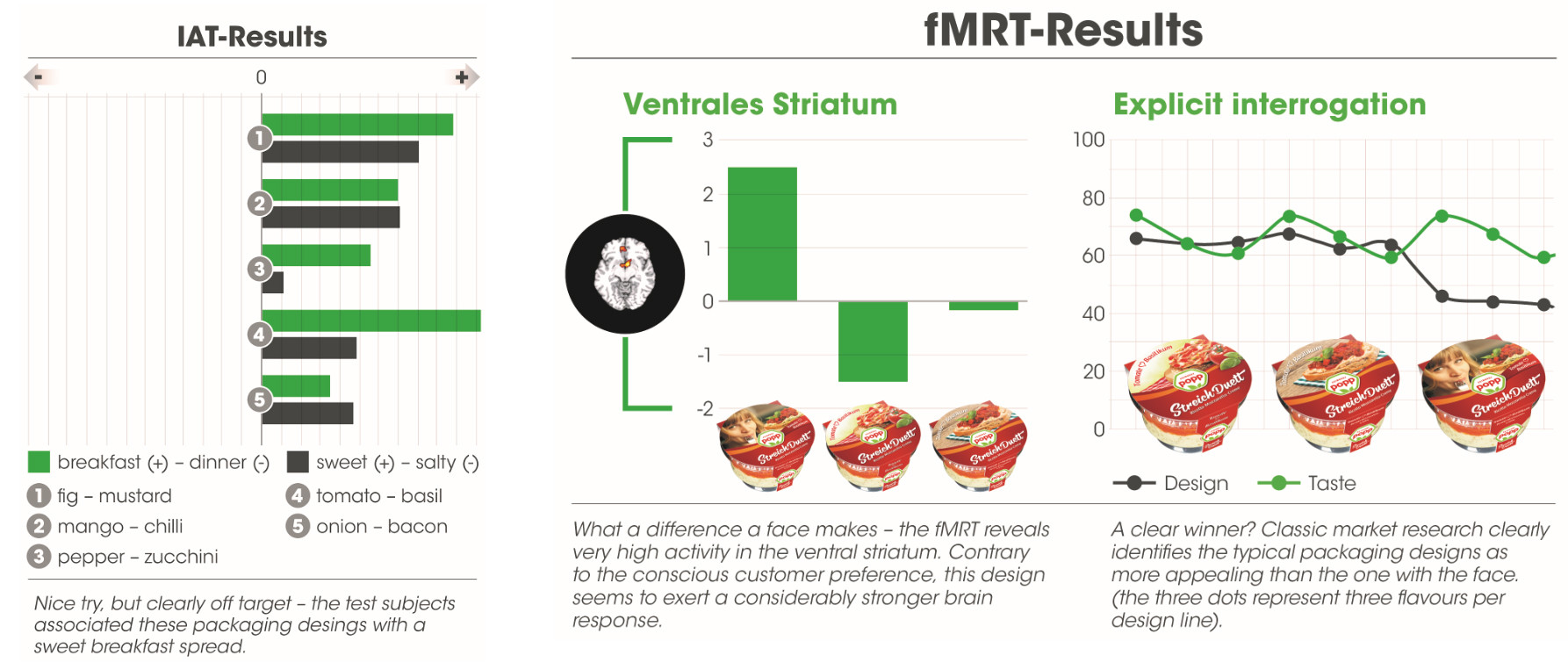Advanced Packaging Design Through Neuroscience
Today’s customers find supermarket shelves increasingly bursting with new products, new flavors and new designs. However, about 80% of all these product innovations fall flat at PoS. Among the many parameters for a successful product launch, packaging design plays a crucial role. In capturing customer attention the design can “make or break” a product at the point of sale. This case study describes a packaging design process that aims at optimizing the saleability of the product based on neuroscience.
Popp Feinkost GmbH is one of Germany’s biggest household names for bread spreads, fine foods and specialty salads. The company used neuromarketing strategies in the packaging design process for a brand new product – “StreichDuett”, a range of chilled spreads to be launched in Germany in 2015. The packaging underwent a full make-over based on results from IAT and fMRI studies a three stage process, conducted by “Kochstrasse™ – Agentur für Marken GmbH”, Hannover and Professor Dr. Weber of Life & Brain GmbH, Bonn.
Approach
Salty rather than sweet. In the initial process stage, marketing agency “Kochstrasse™ – Agentur für Marken GmbH” was commissioned with a rework of already existing layouts. These layouts were based on best practice design guidelines and had been created by one of Popp’s advertising agencies (#1). As desired by the client, Kochstrasse™ only slightly simplified this layout in order to enhance the processing fluency (#2). However, Kochstrasse™ expected the whole design to underperform in terms of consumer comprehensibility. A follow-up implicit association test (IAT), conducted by Prof. Dr. Bernd Weber’s team on the premises of Bonn University confirmed this: While “StreichDuett” clearly had to be positioned as a product for dinner, the packaging evoked impressions of a sweet breakfast. A result diametrically opposed to the desired intention.

Tweak, tune and test. Based on the IAT, Kochstrasse™ redesigned the layouts substantially, including photo shootings and new artworks for two packaging lines. As desired by the client, version 1 (#3) concentrated purely on food imagery. In order to evoke more appropriate associations, Kochstrasse™ recommended an alternative version 2, involving a female portrait on the package (#4). Both versions underwent an fMRI testing procedure at Life & Brain with 40 participants. As expected, both designs performed better than the previous layouts, with a notable difference between the mere food (#3) and human face illustrations (#4). Also, we discovered remarkable differences between implicit and explicit test results.
Results
Implicit, not Explicit. In an explicit interrogation test, the “classic” packaging (#3) performed best, i.e. significantly better than the package layout with the woman’s face (#4). However, these explicit, conscious customer preferences could not be verified in the fMRI. The fMRI results here are clear – and disagree with classic market research: the packaging with the woman’s face (#4) performed best. It yielded the highest activation rate of the participants’ reward centre (ventral striatum). This is especially remarkable, because a number of studies correlate higher fMRI test results with a higher saleability.

Conclusions
The packaging redesign process for Popp Feinkost demonstrates the benefits of close cooperation between designers, neuroscientists, and marketing professionals. The design and testing process clearly revealed weak points in the initial design, helping to avoid making wrong decisions and reach informed design decisions, unbiased in terms of trends or personal taste. Popp Feinkost appreciated these results and will put both packaging designs to field tests. Since various studies suggest a correlation between high fMRI results and good sales performance, the company is now considering the use of a very promising packaging design that otherwise would have been rejected.
This case demonstrates the importance for designers to “speak neuroscience”, i.e. integrating psychometrics and neuroscientific testing methods into the creative workflow. Firstly, neuromarketing input (and testing) greatly enhances the design process from an agency perspective and allows for evaluation of the true emotional impact of a design. Secondly, the translation of “neuro insights” into a creative brief may well be a challenging task, albeit one that generates surprising yet substantial results. Brands from any sector – B2B and B2C – will greatly benefit from this kind of marketing workflow.
CONTACT INFORMATION
Gesa Lischka (Kochstrasse™ – Agentur für Marken GmbH)